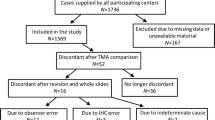Abstract
To assess the variability of oestrogen receptor (ER) testing using immunocytochemistry, centrally stained and unstained slides from breast cancers were circulated to the members of the European Working Group for Breast Screening Pathology, who were asked to report on both slides. The results showed that there was almost complete concordance among readers (kappa=0.95) in ER-negative tumours on the stained slide and excellent concordance among readers (kappa=0.82) on the slides stained in each individual laboratory. Tumours showing strong positivity were reasonably well assessed (kappa=0.57 and 0.4, respectively), but there was less concordance in tumours with moderate and low levels of ER, especially when these were heterogeneous in their staining. Because of the variation, the Working Group recommends that laboratories performing these stains should take part in a external quality assurance scheme for immunocytochemistry, should include a tumour with low ER levels as a weak positive control and should audit the percentage positive tumours in their laboratory against the accepted norms annually. The Quick score method of receptor assessment may also have too many categories for good concordance, and grouping of these into fewer categories may remove some of the variation among laboratories.


Similar content being viewed by others
References
Barnes DM, Hanby AM (2001) Oestrogen and progesterone receptors in breast cancer: past, present and future. Histopathology 38:271–274
Barnes DM, Millis RR, Beex LVAAM, Thorpe SM, Leake RE (1998) Increased use of immunohistochemistry for oestrogen receptor measurement in mammary carcinoma: the need for quality assurance. Eur J Cancer 34:1677–1682
Early Breast Cancer Trialists Collaborative Group (1998) Tamoxifen for early breast cancer: an overview of randomised trials. Lancet 351:1451–1467
Elledge RM, Green S, Pugh R, Allred DC, Clark GM, Hill J, Ravdin P, Martino S, Osborne CK (2000) Estrogen receptor (ER) and progesterone receptor (PgR), by ligand-binding assay compared with ER, PgR and pS2, by immuno-histochemistry in predicting response to tamoxifen in metastatic breast cancer: a Southwest Oncology Group Study. Int J Cancer 89:111–117
Ferrero-Pous M, Trassard M, Le Doussal V, Hacene K, Tubiana-Hulin M, Spyratos F (2001) Comparison of enzyme immunoassay and immunohistochemical measurements of estrogen and progesterone receptors in breast cancer patients. Appl Immunohistochem Mol Morphol 9:267–275
Harvey JM, Clark GM, Osborne CK, Allred DC (1999) Oestrogen receptor status by immunohistochemistry is superior to the ligand-binding assays for predicting response to adjuvant therapy in breast cancer. J Clin Oncol 17:1474–1485
Lacroix M, Querton G, Hennebert P, Larsimont D, Leclercq G (2001) Estrogen receptor analysis in primary breast tumors by ligand-binding assay, immunocytochemical assay, and northern blot: a comparison. Breast Cancer Res Treat 67:263–271
Leake R (2000) Detection of the oestrogen receptor (ER). Immunohistochemical versus cytosol measurements. Eur J Cancer 36[Suppl 4]:S18–S19
Leake R, Barnes D, Pinder S, Ellis I, Anderson L, Anderson T, Adamson R, Rhodes T, Miller K, Walker R (2000) Immunohistochemical detection of steroid receptors in breast cancer: a working protocol. UK Receptor Group, UK NEQAS, The Scottish Breast Cancer Pathology Group, and The Receptor and Biomarker Study Group of the EORTC. J Clin Pathol 53:634–635
Lee H, Douglas-Jones AG, Morgan JM, Jasani B (2002) The effect of fixation and processing on the sensitivity of oestrogen receptor assay by immunohistochemistry in breast carcinoma. J Clin Pathol 55:236–238
Regitnig P, Reiner A, Dinges HP, Hoefler G, Mueller-Holzner E, Lax SF, Obrist P, Rudas M, Quehenberger F (2002) Quality assurance for estrogen and progesterone receptors by immunohistochemistry in Austrian pathology laboratories. Virchows Arch 441:328–334
Rhodes A, Jasani B, Balaton AJ, Barnes DM, Miller KD (2000) Frequency of oestrogen and progesterone receptor positivity by immunohistochemical analysis in 7016 breast carcinomas: correlation with patient age, assay sensitivity, threshold value, and mammographic screening. J Clin Pathol 53:688–696
Rhodes A, Jasani B, Balaton AJ, Miller KD (2000) Immunohistochemical demonstration of oestrogen and progesterone receptors: correlation of standards achieved on in house tumours with that achieved on external quality assessment material in over 150 laboratories from 26 countries. J Clin Pathol 53:292–301
Rhodes A, Jasani B, Barnes DM, Bobrow LG, Miller KD (2000) Reliability of immunohistochemical demonstration of oestrogen receptors in routine practice: interlaboratory variance in the sensitivity of detection and evaluation of scoring systems. J Clin Pathol 53:125–130
Thike AA, Chng MJ, Fook-Chong S, Tan PH (2001) Immunohistochemical expression of hormone receptors in invasive breast carcinoma: correlation of results of H-score with pathological parameters. Pathology 33:21–25
United Kingdom National Coordinating Group for Breast Screening Pathology (2001). Guidelines for non-operative diagnostic procedures and reporting in breast cancer screening. NHSBSP Publication, Sheffield
Zafrani B, Aubriot MH, Mouret E, De Cremoux P, De Rycke Y, Nicolas A, Boudou E, Vincent-Salomon A, Magdelenat H, Sastre-Garau X (2000) High sensitivity and specificity of immunohistochemistry for the detection of hormone receptors in breast carcinoma: comparison with biochemical determination in a prospective study of 793 cases. Histopathology 37:536–545
Author information
Authors and Affiliations
Consortia
Corresponding author
Additional information
The European Working Group for Breast Screening Pathology is supported by the European Commission through the European Breast Cancer Network
Rights and permissions
About this article
Cite this article
The European Working Group for Breast Screening Pathology., Wells, C.A., Sloane, J.P. et al. Consistency of staining and reporting of oestrogen receptor immunocytochemistry within the European Union—an inter-laboratory study. Virchows Arch 445, 119–128 (2004). https://doi.org/10.1007/s00428-004-1063-8
Received:
Accepted:
Published:
Issue Date:
DOI: https://doi.org/10.1007/s00428-004-1063-8




